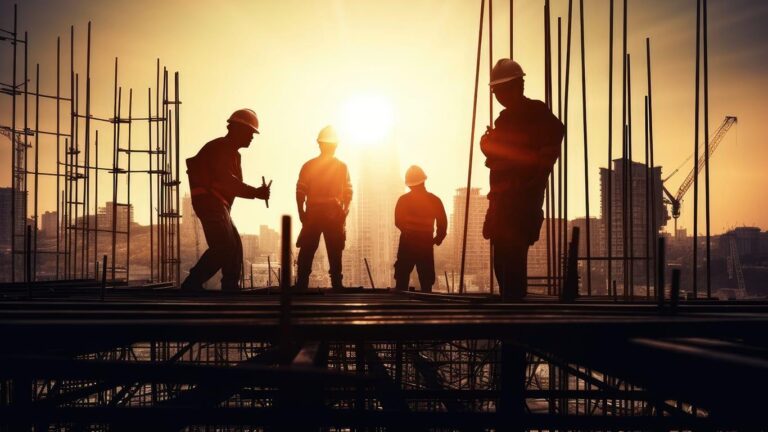Despite a nationwide slowdown in construction activity amid stricter immigration enforcement, Arizona’s construction industry is bucking the trend, demonstrating remarkable resilience and growth. While other states grapple with labor shortages and project delays, Arizona’s sector continues to expand, driven by local demand and adaptive strategies. This divergence highlights how regional factors and policy responses are shaping the industry’s trajectory in the face of broader national challenges.
Arizona construction industry growth bucks national slowdown amid stricter immigration policies
Despite a nationwide deceleration in the construction sector, Arizona is standing out with robust growth fueled by strategic investments and a surge in residential projects. The state’s unique market dynamics, coupled with a booming housing demand and infrastructure upgrades, have offset the challenges posed by tighter immigration policies that have constrained labor availability elsewhere. Industry experts highlight that local contractors are increasingly adopting advanced technologies and optimizing workflows to maintain productivity in the face of workforce shortages.
Key factors contributing to Arizona’s resilience include:
- Expansion of vocational training programs: Developing skilled labor within the state to fill critical gaps.
- Public-private partnerships: Accelerating large-scale infrastructure projects that drive employment.
- Innovative construction methods: Utilizing modular construction and automation to streamline operations.
| Indicator | Arizona (2024) | National Average (2024) |
|---|---|---|
| Construction Employment Growth | 5.4% | 1.2% |
| Residential Permits Issued | 12,800 | 8,400 |
| Infrastructure Spending Increase | 7.3% | 3.1% |
Labor shortages addressed through innovative training programs and local workforce development
Amid a tightening immigration environment, Arizona’s construction sector is turning challenges into opportunities by launching cutting-edge training initiatives and fostering local talent. Industry leaders have partnered with community colleges and vocational schools to deliver tailored certification programs that equip residents with essential skills. These targeted efforts not only accelerate workforce readiness but also enhance job retention, allowing companies to maintain robust project timelines despite labor market pressures.
Key strategies fueling this success include:
- Apprenticeship programs: Hands-on training combined with classroom education providing real-world experience.
- Community outreach: Engaging underrepresented populations, including veterans and youth, expanding the labor pool.
- Soft skills development: Emphasizing teamwork, communication, and leadership to build versatile employees.
| Program | Duration | Enrollment | Completion Rate |
|---|---|---|---|
| Skilled Trades Bootcamp | 12 weeks | 120 | 88% |
| Construction Technology Cert. | 8 weeks | 85 | 92% |
| Veteran Workforce Initiative | 10 weeks | 60 | 95% |
These programs exemplify how Arizona’s construction industry is proactively cultivating a resilient labor force by combining innovative education models with strategic local workforce development. This approach not only counters national shortages but also builds a stronger foundation for sustainable growth in the months and years ahead.
Impact of state regulations on project timelines and costs analyzed in depth
State-specific regulations in Arizona present a complex maze that developers must navigate, exerting significant influence on both project timelines and budget forecasts. Unlike many regions where red tape contributes to delays, Arizona’s regulatory environment has been streamlined to facilitate construction while maintaining necessary oversight. This balance is reflected in expedited permitting processes and phased inspections, allowing projects to progress with minimal bureaucratic bottlenecks. However, compliance requirements related to environmental impact assessments and labor certification still demand strategic planning, often resulting in initial cost escalations but preventing costly mid-project interruptions.
Key regulatory factors impacting timeline and costs include:
- Early-stage permitting and inspection scheduling
- Customized environmental regulations adapted to local ecosystems
- Labor laws influenced by workforce availability and immigration policies
- Fee structures that vary markedly between urban and rural counties
| Regulatory Aspect | Average Impact on Timeline | Estimated Cost Influence |
|---|---|---|
| Permitting & Inspections | 2-4 weeks | +5% |
| Environmental Compliance | 3-6 weeks | +7-10% |
| Labor Certification | Variable | +3-5% |
| Local Fee Variations | Minimal | +2-4% |
Strategies for sustaining growth include increased investment in technology and infrastructure
Arizona’s construction sector is tapping into innovative approaches to ensure its momentum outpaces the national slowdown. Embracing cutting-edge technology such as drone surveying, AI-driven project management, and 3D printing materials has significantly reduced project timelines and improved accuracy on job sites. These technological advances not only boost productivity but also attract a new wave of younger, tech-savvy workers eager to work in a modernized, evolving industry.
Equally important is the concerted effort to expand and modernize infrastructure to support the growing demand. Public-private partnerships have accelerated investments into critical areas including smart transportation networks, sustainable water systems, and energy-efficient buildings. The table below highlights key focus areas where capital infusion is driving tangible improvements:
| Investment Focus | Expected Benefit | Timeline |
|---|---|---|
| Smart Traffic Solutions | Reduced congestion & emissions | 2024-2027 |
| Renewable Energy Integration | Lower operational costs | 2025-2028 |
| Water Infrastructure Upgrades | Enhanced resource sustainability | 2023-2026 |
By prioritizing these innovations and infrastructure projects, Arizona’s construction industry is positioned not just to weather external pressures but to emerge as a blueprint for resilient growth in the post-pandemic economy.
The Way Forward
As the national construction industry contends with labor shortages exacerbated by immigration restrictions, Arizona’s market continues to demonstrate resilience and growth. The state’s ability to adapt through innovative workforce strategies and local policy adjustments highlights a unique dynamic within an otherwise challenging sector. Moving forward, Arizona’s construction industry may serve as a pivotal case study in navigating regulatory pressures while sustaining economic momentum, offering valuable insights for other regions grappling with similar issues.







